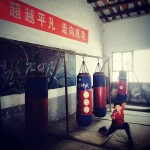I recently came across a very fascinating analysis of the difference between 工夫茶 (gōngfū chá) and 功夫茶 (gōngfuchá) on LanguageLog. Both refer to the art of brewing tea in a clay pot and serving the tea in small cups.
The discussion was fascinating to me in general, because I brew my tea in a clay pot “gong fu style,” but also because the characters that are used most often to describe this method of brewing tea are 功夫茶 – and 功夫 is of course Kung Fu, the martial art and way of life I am researching on this blog.
There are a few phrases used for Kung Fu and all of them have a slightly different meaning and usage. The following are some terms I will use on this blog and the way in which I will use them. I encourage anyone to disagree or augment any of the descriptions I have below:
1) Kung Fu: This is the most common usage outside of China for Chinese martial arts. This is the anglicized version of 功夫, which in modern Mainland pinyin, “the official system to transcribe Chinese characters into Latin script in the People’s Republic of China, Republic of China (Taiwan), and Singapore,” is actually written “gōngfu”. In my own personal communications or blogs, I use gong fu. Here on this blog I will use Kung Fu as much as possible, in order to appeal to a more general audience. I may switch to gong fu because it feels right to me.
2) 功夫 (gōngfu): is used by masters and practitioners I know as the overall term for any work that improves oneself or does “good” i.e.下功夫 (xià gōngfu, “to exert great effort”); as a term to describe a brother in arms 功夫人 (gōngfu rén, “kung fu person”); and as the common colloquial term for martial arts 我们练功夫吧 (wǒmen liàn gōngfu ba, “let’s go practice some gong fu);
3) 武术 (wǔshù) which means quite literally, “martial arts” and is often used as the over-arching term for all physical combat and fitness training. In my experience, wushu is used in a way to denote the school, or art … a more comprehensive word in an organizational way, as in “we belong to the wushu industry” almost. Whereas gong fu is used to denote a philosophy, an esoteric bond between people, an intangible sense of improvement through strenuous effort and also the practical, daily “hitting the bag” training.
3b) wushu is also associated with performance martial arts. A lot of 功夫人 (See above) seem to view performance wushu with disdain. There seems to be a movement to differentiate from “real gong fu” and “flower gong fu”– performance wushu seems to belong to the latter.
4) 太极拳 (tàijí quán, “Taiji or Taiqi Fist”). This term is used to describe a “soft boxing” style that originated in China. Taiji has a very close relationship with Chinese martial arts and gong fu, as well as Taoist principles and the idea of 气 (qì) or prana, breath, vital energy etc. In the West, we commonly use Tai Chi or Tai Qi to describe the slow, soft movements (often punctuated by quick bursts … but that is another post) of this style of martial art. From what I have learned through conversations with masters and practitioners, taiji is an integral part of wushu and gong fu; without it, any self-improvement through gong fu remains stalled … which brings me to this final term for today,
5) 内功 (nèigōng, “internal exertion or strength”) – neigong is the cultivation of qi through taiji movements, meditation, breathing and other techniques. From what I have learned, 外功 (wàigōng, external strength) is just one aspect of gong fu and the true 功夫人 must advance toward neigong in order to reach the pinnacle of martial arts expertise. In fact, the oldest masters tend to focus much more on neigong than on waigong.
Again, I am learning as I go and a lot of this is taken from personal experience (and interpretation) so I encourage everyone who comes across this blog to leave input.



[…] not the case, and the very name of the “style” points to one of the major problems: wu shu means, literally, martial arts. Judo, Taekwondo, Boxing, Wrestling, and the other 2020 nominee Karate, are all a certain martial […]
Well, gongfu cha is never ever used in Taiwan, where the best Wulong and green teas are grown. Here, we talk of Laorencha, “Old peoples’ tea”, lasurely brewed, smelled and drunk, with philosophical talk, a few snacks, on Tatamis and maybe in a public teahouse (those get fewer by the years).
The term Gongfu is also not really used, except the xia gongfu as in “to exert great effort”. We use Lian quan練拳, da quan 打拳, like “train the fistfight” or “do the fistfight (training)”.
Wushu, literaly “martial skills”, has gotten a bad connotation over here, so often we add zhuantong 傳統 in front, meaning “taditional”. I personally often also refer to my training as Wuyi 武藝, an olde rterm, refering to real arts in the martial field.
Taijiquan 太極拳 includes the fist, is containing martial application, but Taiji may be some hippie calisthenics in the west, only toaching for the feel of it, lol. Clear distinction there!
That’s my perspective from Taiwan. Sorry for being late, but an interesting blog. And I will read step by step, and comment if needed. Thank you!
[…] Chinese traditional martial arts from its fundamentals, known by most as traditional kungfu (see this post for more on the malleable terms in wushu), into its component parts: Combat Sports, Wushu […]